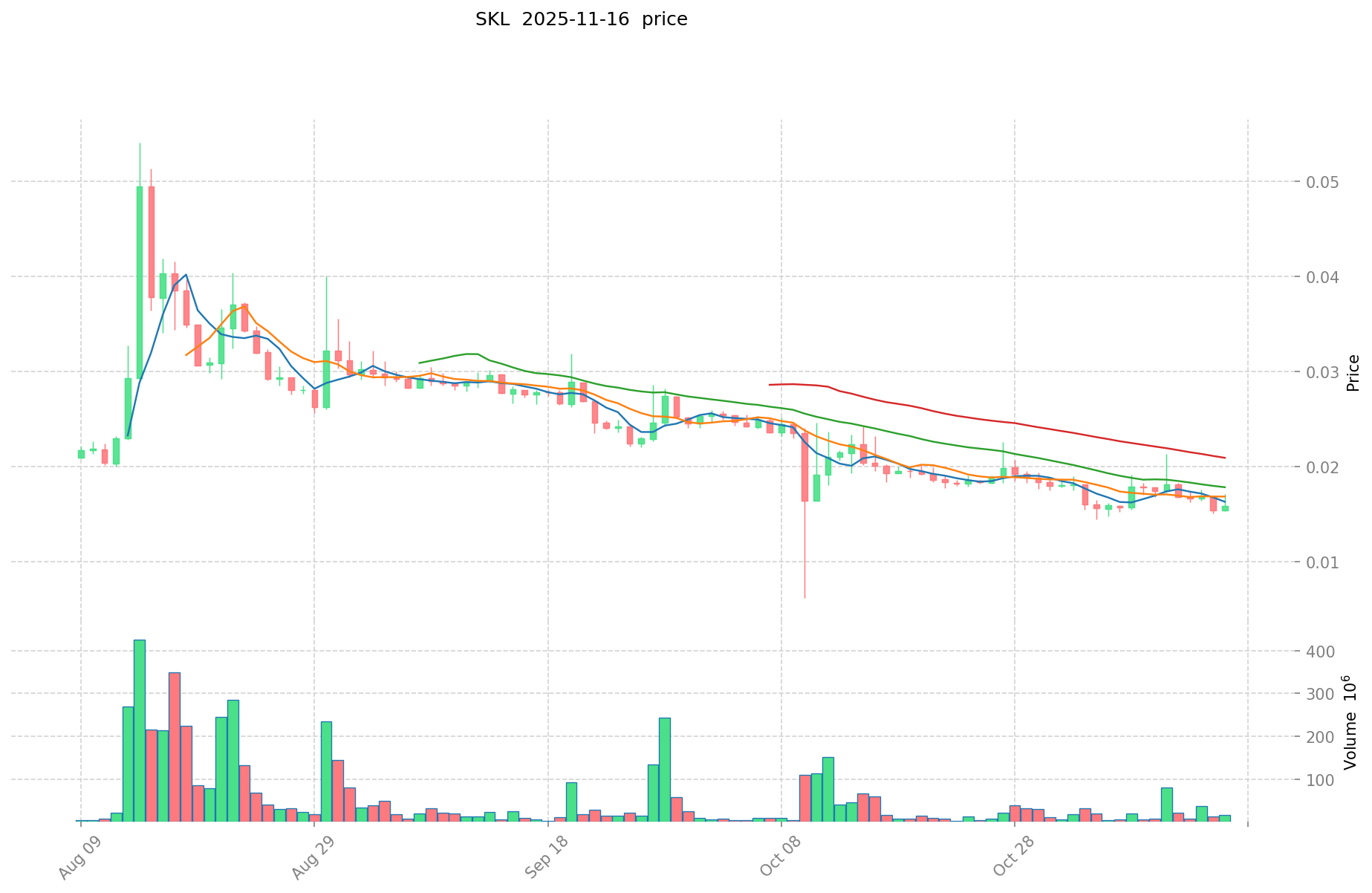What is SKL: Understanding the Synthetic Knowledge Library for Advanced AI Systems
SKALE's Positioning and Significance
In 2020, the NODE Foundation launched SKALE (SKL), aiming to address the challenges of scalability and configurability in blockchain networks.
As an open-source Web3 platform, SKALE plays a crucial role in enhancing the speed and flexibility of blockchain applications, particularly in the areas of DeFi, gaming, and NFTs.
As of 2025, SKALE has become a significant player in the blockchain scalability sector, with an active developer community and growing adoption among dApp creators seeking high-performance solutions.
Origins and Development History
Birth Background
SKALE was created by the NODE Foundation in 2020 to tackle the scalability issues prevalent in blockchain networks. It emerged during a period of rapid blockchain innovation, aiming to provide a more efficient and customizable infrastructure for decentralized applications.
SKALE's launch opened new possibilities for developers and users seeking faster, more cost-effective blockchain interactions.
Key Milestones
- 2020: Mainnet launch, introducing elastic sidechains for improved scalability.
- 2021: Major network upgrades enhancing interoperability and security features.
- 2022: Adoption by several prominent DeFi and NFT projects, driving increased network usage.
- 2023: Ecosystem expansion, with the number of dApps built on SKALE surpassing 100.
With ongoing support from the NODE Foundation and SKALE Labs, SKALE continues to evolve its technology, security, and real-world applications.
How Does SKALE Work?
Decentralized Control
SKALE operates on a network of decentralized nodes distributed globally, free from control by any single entity. These nodes collaborate to validate transactions, ensuring system transparency and attack resistance, thus empowering users with greater autonomy and enhancing network resilience.
Blockchain Core
SKALE's blockchain serves as a public, immutable digital ledger recording all transactions. Transactions are grouped into blocks and linked through cryptographic hashes, forming a secure chain. The records are publicly viewable, establishing trust without intermediaries.
SKALE's unique elastic sidechains technology allows for customizable blockchain environments, significantly enhancing performance and flexibility for dApps.
Ensuring Fairness
SKALE employs a Proof-of-Stake (PoS) consensus mechanism to validate transactions and prevent fraudulent activities like double-spending. Validators stake SKL tokens and run nodes to maintain network security, receiving rewards for their participation.
SKALE's innovation lies in its ability to provide high-throughput, low-latency transactions while maintaining decentralization and security.
Secure Transactions
SKALE utilizes public-private key cryptography to secure transactions:
- Private keys (like secret passwords) are used to sign transactions
- Public keys (like account numbers) are used to verify ownership
This mechanism ensures fund security while maintaining pseudonymity for transactions. SKALE also incorporates additional security features through its modular architecture, allowing for customized security protocols per sidechain.
SKALE (SKL) Market Performance
Circulation Overview
As of November 16, 2025, SKALE's circulating supply is 6,045,894,337 tokens, with a total supply of 6,076,000,000 tokens.
Price Fluctuations
SKALE reached its all-time high of $1.22 on March 12, 2021. Its lowest price was $0.01200554, recorded on October 11, 2025. These fluctuations reflect market sentiment, adoption trends, and external factors.
Click to view the current SKL market price

SKALE Ecosystem Applications and Partnerships
Core Use Cases
SKALE's ecosystem supports various applications:
- DeFi: Decentralized applications providing financial services on the SKALE network.
- GameFi: Projects leveraging SKALE's scalability for blockchain-based gaming experiences.
Strategic Collaborations
SKALE has established partnerships to enhance its technological capabilities and market influence. These partnerships provide a solid foundation for SKALE's ecosystem expansion.
Controversies and Challenges
SKALE faces the following challenges:
- Technical Issues: Scalability and network performance optimization.
- Regulatory Risks: Potential regulatory scrutiny in various jurisdictions.
- Competitive Pressure: The rise of other scalable blockchain solutions.
These issues have sparked discussions within the community and market, driving SKALE's continuous innovation.
SKALE Community and Social Media Atmosphere
Fan Enthusiasm
SKALE's community shows vitality, with growing transaction volumes and user addresses. On X, posts and hashtags related to SKALE often trend, indicating active community engagement.
Social Media Sentiment
Sentiment on X presents a mixed picture:
- Supporters praise SKALE's scalability and potential for dApp development.
- Critics focus on market performance and adoption challenges.
Recent trends show varying sentiment based on market conditions and project developments.
Hot Topics
X users discuss SKALE's scalability solutions, dApp ecosystem growth, and its role in the broader blockchain landscape.
More Information Sources for SKALE
- Official Website: Visit SKALE's official website for features, use cases, and latest updates.
- X Updates: On X, SKALE uses @SkaleNetwork, covering technical upgrades, community events, and partnership news.
SKALE's Future Roadmap
- Ecosystem Goals: Support a growing number of dApps and attract more developers and users.
- Long-term Vision: Become a leading scalable infrastructure for Web3 applications.
How to Participate in SKALE?
- Purchase Channels: Buy SKL on Gate.com
- Storage Solutions: Use compatible Web3 wallets for secure storage
- Participate in Governance: Engage in community decisions through SKALE's governance mechanisms
- Build on the Ecosystem: Visit SKALE's developer documentation to develop dApps or contribute code
Summary
SKALE is redefining blockchain scalability, offering benefits such as high throughput and low-cost transactions. Its active community, rich resources, and technological advancements make it stand out in the cryptocurrency space. Despite facing challenges like market volatility and adoption hurdles, SKALE's innovative spirit and clear roadmap position it as a significant player in the future of decentralized technologies. Whether you're a newcomer or an experienced player, SKALE is worth watching and participating in.
FAQ
What does skl mean in slang?
SKL doesn't have a common slang meaning. In crypto, it refers to SKALE, a blockchain network token.
What does skl do?
SKL powers SKALE, a scalable blockchain network. It's used for staking, governance, and paying for network services, enhancing Ethereum's capabilities.
What is the acronym SKL?
SKL stands for SKALE, a blockchain network designed to enhance Ethereum's scalability and performance.
What does SGE mean in texting?
SGE in texting typically means 'Sorry, Gotta Eat'. It's used to politely end a conversation when someone needs to have a meal.
Share
Content